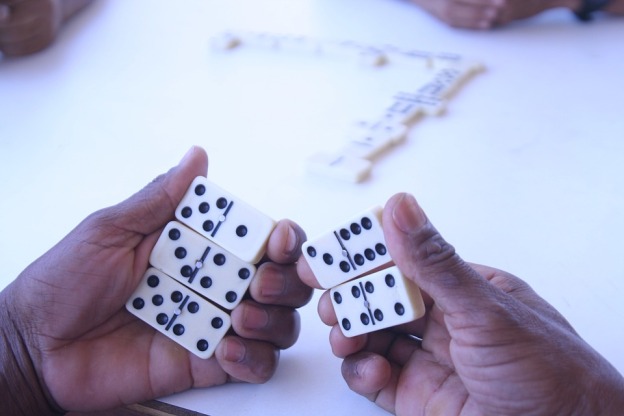Choose a set of rules for dominoes, then pick one of the following variations on score-keeping:
For Addition of Fractions
- Each player keeps track of points individually. For competitive games, individuals keep track of their own scores. For cooperative games, each player keeps track of the total score of the game.
- As players place tiles, the numbers represent fractions rather than integers. The number on the end touching the existing tile is the numerator, and the number on the free end is the denominator.
- Each time a tile is placed, the player must add the resulting fraction to the point total.
- If playing a version where doubles are played sideways, use this as an opportunity to enforce the concept that it doesn’t matter which number is the numerator; the answer is still 1 point for that tile.
For Long Division and Addition of Decimals
- Each player keeps track of points individually. For competitive games, individuals keep track of their own scores. For cooperative games, each player keeps track of the total score of the game.
- As players place tiles, the numbers represent division problems rather than integers. The number on the end touching the existing tile is the dividend, and the number on the free end is the divisor.
- Players must divide the numbers appropriately to how the tile was played, and add the resulting decimal number to the score total. The facilitator may choose to specify a certain number of digits to be used (i.e. – “round to the nearest hundredth”) depending on the skill level and desired outcomes of the game.
- If playing a version where doubles are played sideways, use this as an opportunity to enforce the concept that it doesn’t matter which number is the dividend; the answer is still 1 point for that tile.
For Division with Remainders, Rounding, and Addition of Integers
- Each player keeps track of points individually. For competitive games, individuals keep track of their own scores. For cooperative games, each player keeps track of the total score of the game.
- As players place tiles, the numbers represent division problems rather than integers. The number on the end touching the existing tile is the dividend, and the number on the free end is the divisor.
- Players must divide the numbers appropriately to how the tile was played until a remainder is found. Then, players properly round the answer to the nearest integer and add it to the score.
- If playing a version where doubles are played sideways, use this as an opportunity to enforce the concept that it doesn’t matter which number is the dividend; the answer is still 1 point for that tile.
